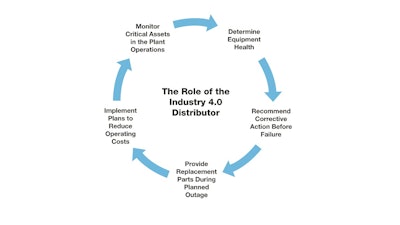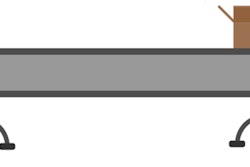
Over the past couple of years, we have all heard about the 4th Industrial Revolution, which some refer to as Industry 4.0 or even the Industrial Internet of Things (IIoT). In a nutshell, the 4th Industrial Revolution references the new role that digital technology and connectivity are and will be playing on the industrial plant floor. Whether it be through advanced automation, cyber-physical systems and autonomous robots, artificial intelligence, 3-D printing or additive manufacturing, analytics, cloud computing and storage…the way we do business is changing at a very rapid pace, and distribution needs to change to remain relevant in the supply chain of tomorrow!
Just to level set, let’s look back in history at what previous industrial revolutions encompassed:
- 1st Industrial Revolution – Water and steam power mechanized the plant floor.
- 2nd Industrial Revolution – Electricity make mass production feasible.
- 3rd Industrial Revolution – Automation, information technology and the internet arrive.
During each time period, distribution played a key role; however, that role has evolved and will continue to evolve as we move into the 4th Industrial Revolution.
So let’s imagine what the role of distribution in the 4th Industrial Revolution might look like. In the typical industrial supply chain today, distributors act primarily as the vehicle for manufacturers to get their final products from the production plant to the end customer. As such, the distributor maintains warehouses, stocks a broad range of finished goods inventory, handles the logistics of products from the manufacturers and then to the end customer. Distributors also finance the inventory they maintain and also finance the receivables from the end customer until the bill is paid. And of course, most industrial distributors field a sales organization that calls directly on the end customer, providing product knowledge, application assistance and other value-added services. For this, the distributor typically sells the products at an agreed-upon markup to the end customer. Pretty straight-forward and simple, right?
Well, what if the role of the distributor in the 4th Industrial Revolution takes on a new twist? What if the distributor’s role moves away from satisfying “reactive demand” by the end user, to a role satisfying what I will refer to as “predictive demand”? Let me explain. Very rapidly, many of the products or critical assets required in the operation of the plant, such as electric motors, gearboxes, pumps, robots, large bearings, etc., will be available with embedded sensors that will have the ability to monitor the health of the product. In most of these applications, if these products within the plant fail, the equipment must be shut down unexpectedly for repair and/or replacement. The result is costly unplanned downtime and lost production. When this happens today, the distributor will do their very best to get a replacement product to the manufacturing plant to minimize the unexpected breakdown and unplanned expenses associated with the failure. And for the most part, distributors do a good job with reactive demand, particularly not knowing from one hour to the next what part is going to fail.
Then comes the 4th Industrial Revolution! Distributors now have the opportunity to change the game as it relates to product failure and costly downtime. No longer is the distributor just a parts supplier, but now the Industry 4.0 distributor becomes a vital link in the uptime supply chain of the manufacturing plant they are supporting. Distribution moves from reactive demand fulfillment to a predictive demand advisor role, such that the distributor provides prescriptive analytics and recommends the appropriate actions in advance of product failure…reducing unplanned downtime, improving the plant’s operating efficiency, and creating more value-add than ever before!
While visiting a large paper mill customer a few months ago, the conversation regarding equipment monitoring, embedded sensors and unplanned downtime came up. The customer said, “I don’t need to collect more data, I just need to understand the data I currently have and figure out how to use it to make my plant operate better!” Sounded like an invitation to provide additional value to a customer that is looking to his distributor partner for help. But not all distributors are ready, willing, and able to make the transition from a “reactive demand” distributor to a “predictive demand” solution provider. The Industry 4.0 distributor must be ready to monitor critical assets on the end customer’s plant floor, determine the equipment performance and health, recommend corrective actions prior to failure, and implement plans that will further reduce the customer’s operating costs on a sustaining basis. Those distributors that don’t make this transition won’t survive in the 4th Industrial Revolution.
 Motion
Motion
So let me wrap this up with a few things to think about if you are in the industrial distribution business. First, things will change and the 4th Industrial Revolution is well on its way to impacting your business. Get onboard or you will be left behind! Second, be open-minded as to what is valued in the mind of your customer. Is it your inventory or your knowledge? Is it your service or your insight? What the customer deems as valuable may differ from you think is valuable, but the customer will pay you for what they value! So don’t be afraid to charge for it. And third, the pace of change is moving faster than it ever has and will continue to accelerate. The Industry 4.0 distributor must be nimble and agile, or they have no chance to win the race!!
Randy Breaux is the CEO of Motion.




















